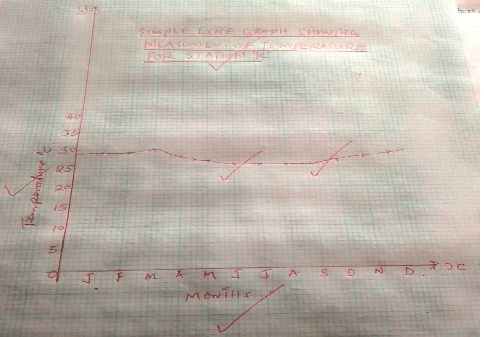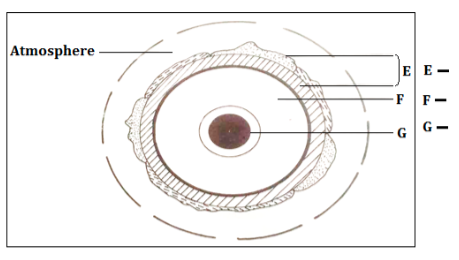INSTRUCTIONS.
- Answer all questions in the spaces provided.
- Name two main branches of Geography. (2mks)
- State three ways in which a student benefits from learning geography. (3mks)
-
- Define the term solar system. (2mks)
- Differentiate between meteors and meteorites. (2mks)
- State four proofs that the earth is spherical. (4mks)
- The diagram below represent the structure of the earth us it to answer questions. Name the layers marked E, F and G. (3mks)
-
- Give five elements of weather and the instrument that measuring them. (5mks)
- What is weather forecasting? (2mks)
- State three factors that limits weather forecasting. (3mks)
-
- Use the statistic in the provided table below, draw a simple line graph, using a vertical scale of 1 cm to represent 5°C. (5mks)
Month J F M A M J J A S O N D Temp °C 29 29 30 28 27 26 26 26 26 27 28 29 - State three advantages of simple line graph. (3mks)
- Use the statistic in the provided table below, draw a simple line graph, using a vertical scale of 1 cm to represent 5°C. (5mks)
-
- Differentiate between A map and a Picture. (2mks)
- Outline five characteristics of a good sketch map. (5mks)
- Convert the following representative fraction scale/ratio scale into statement scale.
- 1:500,000 (2mks)
- 1:10,000 (2mks)
- Students of your school intend to carry out field study in a weather station.
- State four ways the students would prepare for the fieldwork? (5mks)
- List three methods that you would use to collect data. (3mks)
- State three problems likely to encounter during field work. (3mks)
-
- Define the term minerals. (2mks)
- State four characteristics of minerals. (4mks)
- Name three types of minerals. (3mks)
-
- Define the term mining. (2mks)
- Outline four ways in which minerals occur. (4mks)

MARKING SCHEME
-
- Name two main branches of Geography. (2mks)
- Physical geography
- Human and economic geography
- Outline three ways in which a student benefits from learning geography. (3mks)
- The learner is able to explain the origin of the earth and solar system.
- Subject helps a learner to develop skills of observation.
- Geography enables a learner to understand and appreciate different environment.
- Geography encourages international awareness.
- Study of fieldwork teaches on how to manage time properly.
- Name two main branches of Geography. (2mks)
-
- Define the term solar system. (2mks)
- Solar system is made up of the sun with eight planets orbiting around it.
- Differentiate between meteors and meteorites. (2mks)
- Meteors are small heavenly bodies that enter the earth’s atmosphere from the universe at a very fast speed while meteorites are those meteors that pass through the atmosphere fail to burn up and land on the surface of the earth as large rocks.
- Outline three proofs that the earth is spherical. (3mks)
- Circumnavigation – sailing or flying around the earth.
- Approaching ship on a port.
- The earth rotates from west to east.
- The shadow of the earth appears spherical.
- Since all planet are round when observed in a telescope then the earth must be round.
- The diagram below represent the structure of the earth us it to answer questions.
Name the layers marked E, F and G. (3mks)- E – Crust
- F – Mantel
- G – Core
- Define the term solar system. (2mks)
-
- Give five elements of weather and the instrument that measuring them. (5mks)
- Temperature - thermometer
- Humidity – hygrometer
- Precipitation (rainfall) – rain gauge
- Air pressure – Barometer
- Wind direction – wind vane
- Sunshine – sunshine recorder
- Cloud cover – fraction or % of the sky covered by cloud.
- What is weather forecasting? (2mks)
- Weather forecasting is the predication of a weather situation of a given place within a short period of time.
- List three factors that limits weather forecasting. (3mks)
- Inadequate data
- Inadequate/unreliable data
- Inadequate personnel and lack of skills.
- Use of defective and obsolete equipments.
- Vagaries of nature such as storm and earthquake.
- Give five elements of weather and the instrument that measuring them. (5mks)
-
- Use the statistic in the provided table below, draw a simple line graph, use the scale 1 cm represent 5°C. (5mks)

- State three advantages of simple line graph. (3mks)
- It is easy to construct and draw.
- It is easy to read and interpret.
- It enables easy comparisons of variation.
- Use the statistic in the provided table below, draw a simple line graph, use the scale 1 cm represent 5°C. (5mks)
-
- Differentiate between A map and a Picture. (2mks)
- A map is a representation of a part of the earth or the whole earth on a flat surface like a sheet of paper while a picture is an image of an actual objects represented either in a drawing, painting or photograph.
- Outline five characteristics of a good sketch map. (5mks)
- Must be neat and clear
- Have a title
- Must have a key
- Must be enclosed in a frame
- Have a compass direction
- Convert the following representative fraction scale/ratio scale into statement scale.
- 1:500,000 (2mks)
1km = 100,000cm
? = 500,000 cm
= 1 x 500000
100000
= 5km
Statement scale will be 1cm rep 5km. - 1:10,000 (2mks)
If 1km = 100000cm
? = 10000cm
= 1 x 10000
100000
= 0.1 km
Statement scale = 1cm rep 0.1km
- 1:500,000 (2mks)
- Differentiate between A map and a Picture. (2mks)
-
- Students of your school intend to carry out field study in a weather station.
- What are the ways the students were to prepare for the fieldwork? (5mks)
- Seek permission
- Conduct are connaisance
- Adjust objective and hypothesis
- Choose methods of data collection.
- Assemble necessary tools
- Divide the students in groups
- Prepare a working schedule.
- State three primary/direct methods of data collection. (3mks)
- Questionnaire
- Interview
- Taking photographs
- State three problems likely to encounter during field work. (3mks)
- Researcher may fall sick
- Responded may become uncooperative
- A language barrier
- Transport problem
- Environmental constrain
- What are the ways the students were to prepare for the fieldwork? (5mks)
- Students of your school intend to carry out field study in a weather station.
-
- Define the term minerals. (2mks)
- Minerals are inorganic homogenous substances occurring naturally at or below the earth surface.
- Outline five characteristics of minerals. (5mks)
- Have different degree of hardness
- Minerals have varying number of elements.
- Some minerals have atoms arranged orderly manner to form crystals.
- Some minerals have different ability to allow light to pass through
- Some minerals have specific colour
- Minerals have different texture
- Minerals differ in streaks.
- Name three types of minerals. (3mks)
- Metallic mineral
- Non-metallic minerals
- Energy mineral.
- Define the term minerals. (2mks)
-
- Define mining. (2mks)
- Mining refers to all attempts to extract valuable minerals either solid, liquid or gas from the earth’s crust.
- Outline the factors influencing the occurrence of minerals. (3mks)
- Veins and lodies
- Beds and seams
- Weathering products
- Alluvial or place deposits
- Define mining. (2mks)
Join our whatsapp group for latest updates
Tap Here to Download for 50/-
Get on WhatsApp for 50/-
Download Geography Questions and Answers - Form 2 Term 1 Opener Exams 2023.
Tap Here to Download for 50/-
Get on WhatsApp for 50/-
Why download?
- ✔ To read offline at any time.
- ✔ To Print at your convenience
- ✔ Share Easily with Friends / Students


